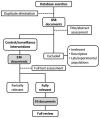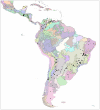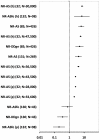Community participation in Chagas disease vector surveillance: systematic review
- PMID: 21713022
- PMCID: PMC3119642
- DOI: 10.1371/journal.pntd.0001207
Community participation in Chagas disease vector surveillance: systematic review
Abstract
Background: Vector control has substantially reduced Chagas disease (ChD) incidence. However, transmission by household-reinfesting triatomines persists, suggesting that entomological surveillance should play a crucial role in the long-term interruption of transmission. Yet, infestation foci become smaller and harder to detect as vector control proceeds, and highly sensitive surveillance methods are needed. Community participation (CP) and vector-detection devices (VDDs) are both thought to enhance surveillance, but this remains to be thoroughly assessed.
Methodology/principal findings: We searched Medline, Web of Knowledge, Scopus, LILACS, SciELO, the bibliographies of retrieved studies, and our own records. Data from studies describing vector control and/or surveillance interventions were extracted by two reviewers. Outcomes of primary interest included changes in infestation rates and the detection of infestation/reinfestation foci. Most results likely depended on study- and site-specific conditions, precluding meta-analysis, but we re-analysed data from studies comparing vector control and detection methods whenever possible. Results confirm that professional, insecticide-based vector control is highly effective, but also show that reinfestation by native triatomines is common and widespread across Latin America. Bug notification by householders (the simplest CP-based strategy) significantly boosts vector detection probabilities; in comparison, both active searches and VDDs perform poorly, although they might in some cases complement each other.
Conclusions/significance: CP should become a strategic component of ChD surveillance, but only professional insecticide spraying seems consistently effective at eliminating infestation foci. Involvement of stakeholders at all process stages, from planning to evaluation, would probably enhance such CP-based strategies.
Conflict of interest statement
The authors have declared that no competing interests exist.
Figures




References
-
- Clayton J. Chagas disease 101. Nature. 2010;465(7301):S4–S5. - PubMed
-
- Lent H, Wygodzinsky P. Revision of the Triatominae (Hemiptera, Reduviidae), and their significance as vectors of Chagas' disease. Bull Am Mus Nat Hist. 1979;163:123–520.
-
- Dias JCP. Elimination of Chagas disease transmission: perspectives. Mem Inst Oswaldo Cruz. 2009;104(Suppl.1):41–45. - PubMed
-
- Moncayo A, Silveira AC. Current epidemiological trends for Chagas disease in Latin America and future challenges in epidemiology, surveillance and health policy. Mem Inst Oswaldo Cruz. 2009;104(Suppl.1):17–30. - PubMed
Publication types
MeSH terms
LinkOut - more resources
Full Text Sources
Medical
Miscellaneous

